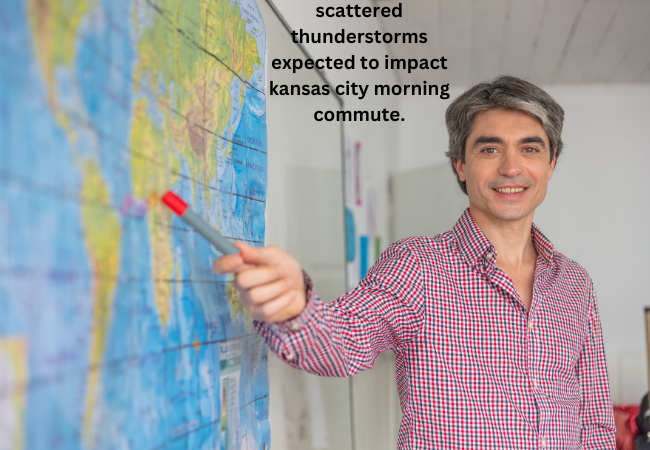scattered thunderstorms expected to impact kansas city morning commute.

What Are Scattered Thunderstorms?
Scattered thunderstorms are a type of weather phenomenon characterized by isolated storms that occur in a specific area. Unlike isolated thunderstorms, which are even more sporadic, or widespread thunderstorms, which cover a large area, scattered thunderstorms appear intermittently and can be quite unpredictable. These storms often bring heavy rain, lightning, and occasionally hail or strong winds.
Weather Forecast for Kansas City
Currently, Kansas City is experiencing warm, humid conditions, which are ripe for thunderstorm development. Meteorologists predict that scattered thunderstorms will begin early in the morning and could persist throughout the day. The sporadic nature of these storms means that some areas may experience heavy rainfall, while others might remain dry.
Impact on the Morning Commute
Expected Challenges for Commuters
Morning commuters should anticipate potential delays and hazardous driving conditions. Heavy rain can reduce visibility and create slippery roads, increasing the risk of accidents. Lightning and strong winds are also concerns, particularly for those driving on open highways or in rural areas.
Areas Likely to Be Most Affected
While the entire Kansas City area could see thunderstorms, certain regions might be more prone to severe weather. Low-lying areas and regions with poor drainage could experience temporary flooding, making roads impassable. It’s essential to monitor local news and weather updates for specific warnings.
Safety Precautions for Commuters
General Tips for Driving in Thunderstorms
- Slow Down: Wet roads reduce traction, so driving at a slower speed helps maintain control.
- Increase Following Distance: Leave more space between your vehicle and the one in front to allow for longer stopping distances.
- Use Headlights: Make sure your headlights are on, even during the day, to improve visibility.
Specific Advice for Kansas City Roads
Kansas City’s infrastructure includes several highways and bridges that can be particularly hazardous in storms. Avoiding these areas during severe weather can reduce your risk. Additionally, be cautious of flooded underpasses and avoid driving through standing water.
Public Transportation Concerns
Potential Delays and Disruptions
Public transportation systems, including buses and trains, might face delays due to the weather. Lightning can disrupt electrical systems, and heavy rain can cause flooding on tracks and roads.
Tips for Public Transit Users
- Check Schedules: Verify bus and train schedules in advance and look for real-time updates.
- Allow Extra Time: Plan to leave earlier than usual to accommodate potential delays.
- Stay Informed: Use transit apps to receive alerts about route changes or cancellations.
School and Work Considerations
Possible Impact on School Schedules
Schools may delay start times or close entirely if the weather conditions are severe enough. Parents should stay tuned to local news and school district communications for updates.
Advice for Employees and Employers
Employers should consider flexible scheduling or remote work options to ensure the safety of their employees. Employees, in turn, should communicate with their supervisors about any weather-related issues affecting their commute.
Local Authorities’ Preparedness
Measures Taken by Local Authorities
Local authorities typically have protocols in place for severe weather, including emergency response teams and communication strategies. They may also deploy additional resources to manage traffic and address any weather-related incidents.
How the Community Can Stay Informed
Staying informed through local news channels, weather apps, and community alert systems is vital. Signing up for emergency alerts can provide timely updates and safety instructions.
Impact on Flights and Air Travel
Expected Delays and Cancellations
Air travelers should prepare for possible delays and cancellations due to thunderstorms. Severe weather can lead to flight rerouting or temporary airport closures.
Tips for Travelers
- Check Flight Status: Regularly monitor your flight status through the airline’s website or app.
- Plan for Extra Time: Arrive at the airport earlier than usual to navigate any disruptions.
- Stay Updated: Use travel apps for real-time updates on delays and gate changes.
Health and Safety Tips
Protecting Yourself from Lightning
- Seek Shelter: If you’re outdoors, move inside a sturdy building or vehicle at the first sign of lightning.
- Avoid Electrical Appliances: Do not use electrical appliances or plumbing fixtures during a thunderstorm to avoid electrical shocks.
Dealing with Potential Flooding
- Move to Higher Ground: In case of flooding, head to higher ground immediately.
- Avoid Flooded Areas: Never attempt to walk or drive through flooded streets, as the depth and current can be deceptive.
Technology and Tools to Stay Informed
Recommended Weather Apps and Websites
- The Weather Channel: Provides real-time weather updates and alerts.
- AccuWeather: Offers detailed forecasts and radar maps.
- NOAA Weather Radar: A reliable source for severe weather warnings.
Importance of Real-Time Updates
Real-time updates can make all the difference in staying safe during scattered thunderstorms. Utilize these tools to get minute-by-minute information on weather conditions in your area.
Community Response and Support
How Locals Can Help Each Other
Neighbors can support each other by sharing updates and offering assistance, especially to those who may be more vulnerable, such as the elderly or those without access to transportation.
Community Resources Available
Local community centers and shelters may provide resources and assistance during severe weather. Keep a list of these resources handy in case you need them.
Case Studies of Past Thunderstorms in Kansas City
Lessons Learned from Previous Events
Kansas City has experienced significant thunderstorms in the past, each providing valuable lessons in preparedness and response. These events highlight the importance of community awareness and readiness.
Improvements Made Over Time
Over the years, improvements in infrastructure and emergency response have enhanced the city’s ability to handle severe weather. Continued investment in these areas remains crucial for future safety.
Environmental Impact
How Thunderstorms Affect the Local Ecosystem
Thunderstorms can have both positive and negative effects on the local ecosystem. While they provide much-needed rain, they can also cause soil erosion and damage to vegetation.
Long-Term Weather Patterns and Climate Change
Understanding how scattered thunderstorms fit into broader climate patterns is essential. These events can be indicators of changing weather trends and help inform future climate resilience strategies.
Conclusion
Scattered thunderstorms are a natural part of Kansas City’s weather patterns, but they require preparedness and vigilance, especially during the morning commute. By staying informed and taking the necessary precautions, you can navigate these storms safely and minimize their impact on your day.
FAQs
What should I do if I’m caught in a thunderstorm while driving?
If you’re caught in a thunderstorm while driving, pull over to a safe location, turn on your hazard lights, and wait for the storm to pass. Avoid touching metal surfaces inside the car.
How can I stay updated on the weather conditions?
You can stay updated on weather conditions by using weather apps, checking local news, and signing up for emergency alerts.
What are the signs of a thunderstorm approaching?
Signs of an approaching thunderstorm include darkening skies, increasing wind, and the sound of distant thunder.
How do scattered thunderstorms affect air travel?
Scattered thunderstorms can cause flight delays and cancellations due to lightning and turbulence. It’s essential to check your flight status frequently.
Are there any community alerts I should sign up for?
Yes, signing up for local emergency alerts and weather notifications can provide you with timely information and safety instructions.


